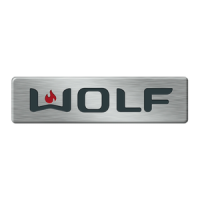What does CRC defaul values fault mean on my Wolf Boiler?
- MMelissa WilliamsSep 5, 2025
If your Wolf Boiler displays a CRC default values fault, it indicates that the EEPROM record "Master reset" is invalid. To resolve this, replace the control PCB.

What does CRC defaul values fault mean on my Wolf Boiler?
If your Wolf Boiler displays a CRC default values fault, it indicates that the EEPROM record "Master reset" is invalid. To resolve this, replace the control PCB.
How to fix TBV excess temperature on Wolf CGB-K-20 Boiler?
If your Wolf Boiler shows a TBV excess temperature error, it means the flow temperature has exceeded the limit for TBV shutdown, possibly due to a severely contaminated heat exchanger. To resolve this, check the system pressure and heating circuit pump. Also, check the HC pump step switch, vent the heating system, and then press the reset button.
What to do if my Wolf CGB-K-20 shows TW excess temperature?
If your Wolf Boiler displays a TW excess temperature error, indicating that the flow/return temperature has exceeded the limit for TW shutdown, check the system pressure and vent the heating system. Additionally, set the pump to stage 2 or 3.
What to do if my Wolf Boiler gas fan doesn't stop?
If the gas fan in your Wolf Boiler does not stop, check the gas fan supply cable and the gas fan itself. After checking, press the reset button.
What causes TBA excess temp. in Wolf CGB-K-20?
If your Wolf Boiler is showing TBA excess temp, it means that the flue gas temperature has exceeded the limit for TBA shutdown. Check for correct installation of the combustion chamber pot.
What to do if my Wolf CGB-K-20 Boiler gas fan does not reach the required pre-purging speed?
If the gas fan in your Wolf Boiler does not reach the required pre-purging speed, check the gas fan supply cable and the gas fan. Then, press the reset button.
What does Incorrect BCC mean on Wolf CGB-K-20?
If your Wolf Boiler shows Incorrect BCC, it means that the boiler coding card is incompatible with the control unit PCB, so refit the correct parameter plug.
What to do if my Wolf CGB-K-20 shows Gas valve „1“ fault?
If your Wolf Boiler displays a Gas valve "1" fault, and a flame is recognized 15 seconds after burner operation even if gas valve 1 has received a shutdown command, replace the gas combination valve.
What to do if the flow sensor is faulty in my Wolf Boiler?
If the flow sensor in your Wolf Boiler is faulty, meaning the flow temperature sensor or lead is faulty, check the lead and the flow sensor.
What to do if my Wolf CGB-K-20 Boiler has a fault in the 24 VAC supply?
If your Wolf Boiler indicates a fault in the 24 VAC supply, meaning the 24 V AC supply is outside the permissible range (e.g., short circuit), check the three-way valve and the gas fan.
| Type | Condensing Boiler |
|---|---|
| Energy Efficiency Class | A |
| Operating Pressure | 3 bar |
| Efficiency | Up to 98% |
| Gas Connection | G ¾ |
Procedures to follow if you smell gas, including actions to prevent fire and explosion.
Actions to take if you smell flue gas to prevent poisoning.
Precautions during fuse replacement to avoid electrocution.
Information on protecting the boiler from freezing and potential water damage.
Awareness of risks associated with ice formation on balanced flue pipes.
Guidelines for proper installation and modification by qualified personnel.
Avoiding corrosive materials to prevent damage to the boiler and flue system.
Instructions for cleaning the boiler casing safely.
User obligations for regular system maintenance and servicing.
Procedure and precautions for filling the heating system with water.
Requirements for fitting and filling the siphon correctly.
Instructions for operating the various shut-off valves.
Regularly checking the system water level and pressure gauge.
Explanation of the illuminated ring's meaning as a status indicator.
Guide to selecting operating modes and adjusting temperature settings.
Tips on reducing energy consumption through efficient heating and control.
Importance of regular maintenance and adequate air circulation for efficiency.
Strategies to prevent heat loss from rooms and through ventilation.
Optimising DHW settings, circulation pumps, and understanding fault codes.
